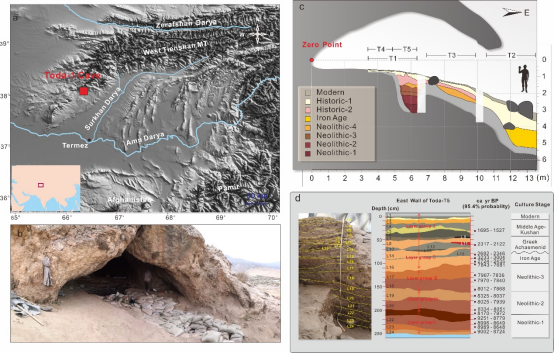An international research team has documented evidence of early barley harvesting and consumption in a pre-pottery Neolithic culture in Central Asia, a finding that challenges long-held narratives about the origins of agricultural practices beyond West Asia's Fertile Crescent and fills a critical gap in understanding global agricultural dispersal.
The study, published in the Proceedings of the National Academy of Sciences (PNAS) on August 25, details excavations at Toda Cave 1 in the Surkhan Valley of southern Uzbekistan-an area strategically located at the crossroads of East, West, South, and North Asia, historically a hub for ancient human and cultural exchanges. Led by researchers from the Institute of Vertebrate Paleontology and Paleoanthropology (IVPP) of the Chinese Academy of Sciences, Northwest University, Uzbekistan's Archaeological Institute of Cultural Relics (Samarkand), and Germany's Max Planck Institute for Geoanthropology, the team analyzed remains dating to approximately 9,000 calendar years before present (cal yr BP).
The Neolithic Revolution, often tied to the domestication of cereal grains like wheat and barley in the Fertile Crescent some 10,000 years ago, laid the groundwork for agricultural societies and the rise of civilizations in Mesopotamia and ancient Egypt. For decades, however, archaeologists have debated whether groups beyond this core region-particularly in the vast grasslands of inland Asia-independently attempted or succeeded in domesticating Triticeae grasses, a family that includes wheat, barley, and rye.
The Toda Cave 1 findings address this question directly. Through systematic archaeobotanical analysis, the team identified barley seeds, pulses, and other plant remains from the pre-pottery Neolithic layer. Radiocarbon dating placed the oldest barley seeds at 9133-8970 cal yr BP, confirming that barley gathering had become a stable subsistence practice in Central Asia's piedmont zones by at least 9,000 years ago-persisting for millennia thereafter.
Notably, the barley included both hulled and naked (hull-less) varieties. While morphological traits such as thickness-width ratios classified the grains as wild barley, nearly half were naked barley-a proportion far higher than that found at contemporary early agricultural sites in the Near East. The researchers noted, this unusual ratio suggests a distinct evolutionary trajectory for barley use in Central Asia, separate from the Fertile Crescent model.
Complementing the plant evidence, the team uncovered microlithic stone blades with "sickle gloss"-a telltale surface wear caused by repeated use in cutting cereal stalks-indicating these tools were used as sickle inserts for harvesting. The site also yielded grinding stones with traces of cereal and pulse processing, forming a complete operational chain from crop harvesting to milling.
Additionally, remains of pistachio shells and wild apple seeds at the cave reflect the breadth of plant resources exploited by the pre-pottery Neolithic population, suggesting a diverse subsistence strategy rather than reliance on a single crop.
Palynological (pollen) and organic isotopic analyses further contextualized the findings, revealing that the region's vegetation 9,000 years ago included extensive tree cover and a high concentration of C4 plants-signs of a climate markedly wetter than today's arid conditions. The researchers attributed this favorable environment to an intensified South Asian monsoon, which boosted regional precipitation and likely supported the development of pre-pottery Neolithic cultures and their cereal-gathering practices.
The study pushes back the recorded history of cereal use in Uzbekistan by nearly 4,000 years, according to the research team. Beyond extending the timeline, it provides critical data for defining the cultural typology and economic models of pre-pottery Neolithic societies in Central Asia-a region that has long been labeled a "missing link" in global agricultural origin stories due to limited prior research.
The study was funded by the National Key R&D Program of China and the Chinese Academy of Sciences Project for Young Scientists in Basic Research, among other sources.

Location of Toda No.1 Cave in Uzbekistan, stratigraphic distribution, entrance photo and chronological stratigraphy. (Image by IVPP)

Charred seeds unearthed from Toda-1 Cave. (Image by IVPP)






